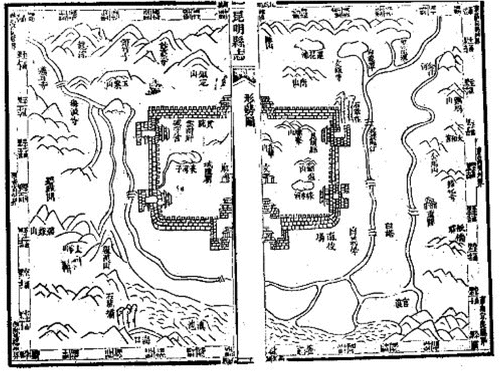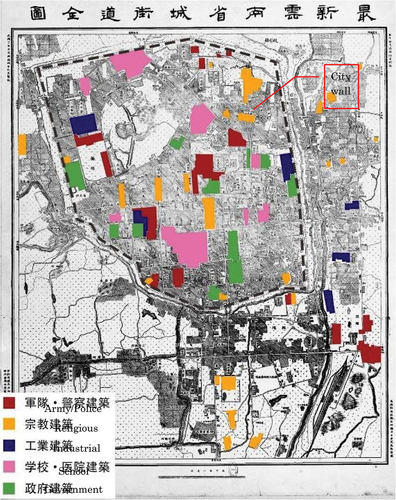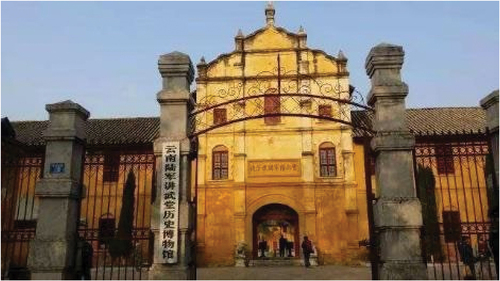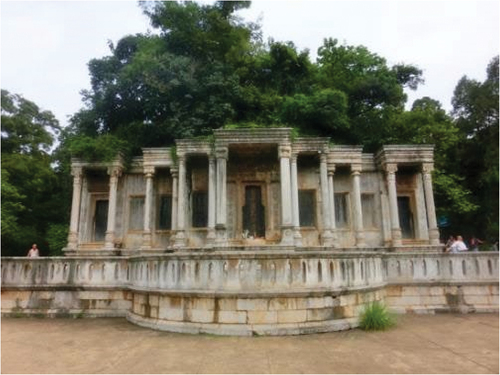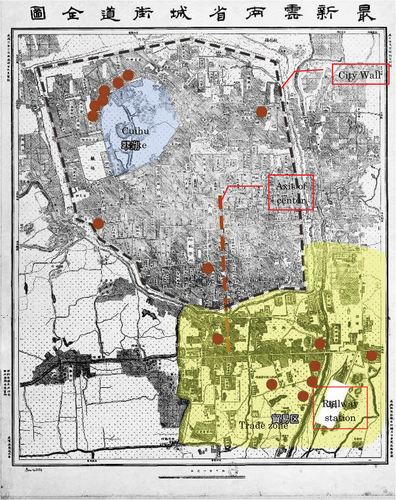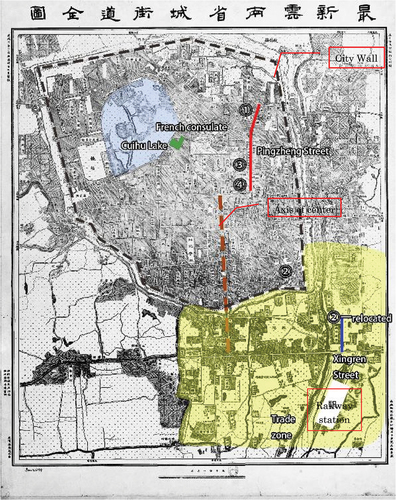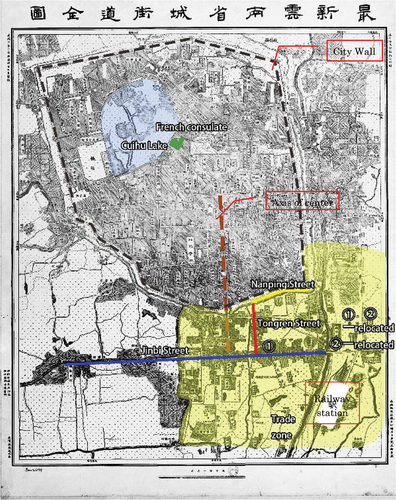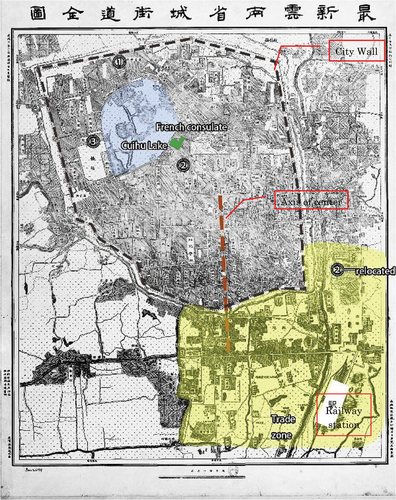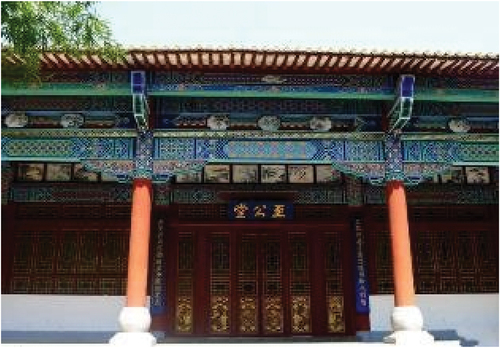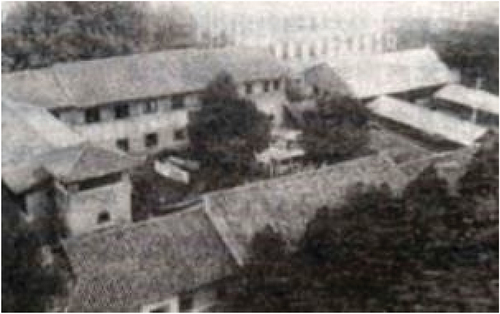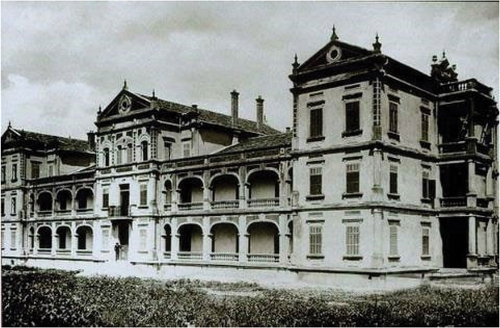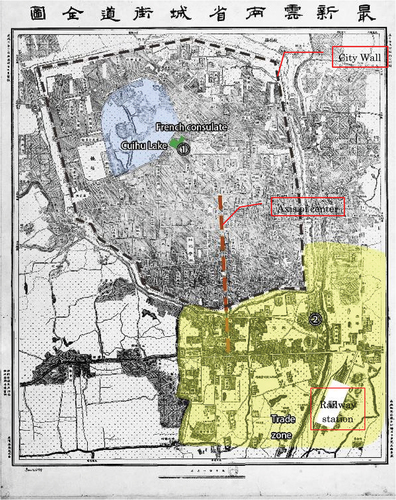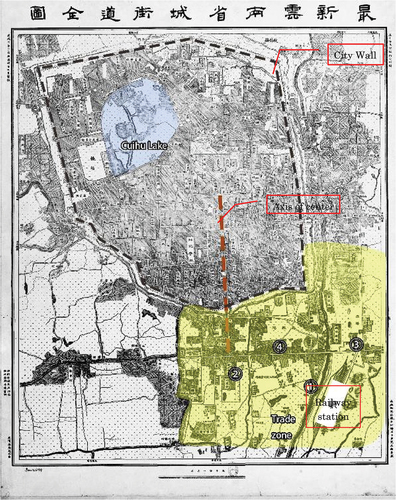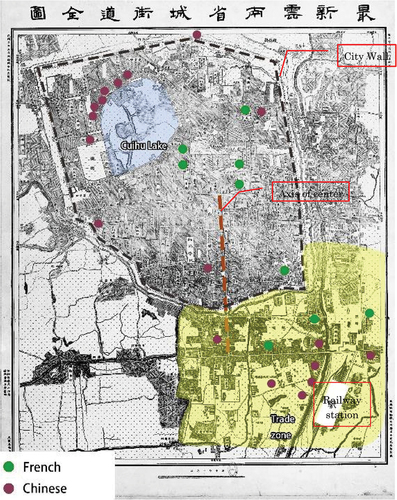ABSTRACT
In this study, we seek to clarify the characteristics of French Inspired urban architecture in Kunming at the architectural level, as well as the construction process of the French Inspired urban architecture and its relation to the urban landscape of Kunming. With the opening of the International Railway, new construction techniques and materials were introduced into Kunming, and many unconventional architectural works with masonry construction appeared. In addition, after this trend of Western aesthetics started, Western architectural styles such as the French Inspired appeared, and the styles of decorative columns and semi-circular windows were applied to buildings. In addition, aspects of modern interiors such as mosaic tiles appeared in architectural interiors. French Inspired architecture influenced the modernization of Kunming’s architecture through its building techniques, promoting the openness and development of Kunming’s cities and spreading the production techniques, lifestyles, ideologies, and culture of modern Western society to Yunnan, through which these values, lifestyles, daily necessities, and customs influenced Kunming society. On the other hand, in terms of architectural design, many French Inspired buildings incorporate elements of Kunming’s indigenous architectural styles as well as elements of Chinese architecture, such as floor plans, roofs, windows, and doors, creating a multicultural fusion.
GRAPHICAL ABSTRACT
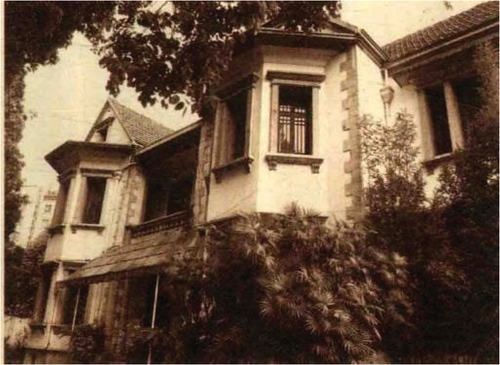
1. Introduction
1.1. Research background
Kunming is the capital of Yunnan Province, China, which borders Southeast Asia, and is the political, economic, cultural, and transportation center of the province. Kunming has a long history stretching across more than 2,300 years, and was registered as one of China’s famous historical and cultural cities in 1982.
The city wall of Kunming1 was built in 1382 by the Ming Dynasty’s Mu Ying, and was removed during the urban renewal from 1922 to 1951, following the construction of the Yunnan-Vietnam Railway, which was completed in 1910. This railroad was built by the French to expand their influence in Southwest China and Southeast Asia by connecting Hanoi in Vietnam and Kunming in China. Construction in China began in 1903, and the entire line was completed and opened to traffic in 1910.
With the opening of the new railroad, a new trade zone was opened in Kunming, bringing an influx of French and Vietnamese merchants to the city. Not only the churches and houses built by foreigners, but also those of the local Chinese, mainly of the upper classes, reflected the French Inspired under the influence of foreign culture, greatly changing the style of urban architecture in Kunming. After the withdrawal of French power from Kunming, changes in ownership and cultural backgrounds led to the conversion of the French Inspired buildings. These French Inspired buildings are considered to have played an important role in the architectural history and urban landscape of Kunming.
In 1943, the French and Chinese governments broke off diplomatic relations and the Chinese government took over the Yunnan-Vietnam Railway. In Kunming, the operation of the railroad was suspended around 2004 due to deterioration of its cost-effectiveness and transportation efficiency, and it was gradually dismantled in 2017 for the construction of an urban subway. At the end of 2018, the Kunming Municipal Planning and Design Institute released a plan, the Kunming Plan for the Protection and Use of the Yunnan-Vietnam Railway and Design Items for the Modification of the Railway Line, aimed to register the Yunnan-Vietnam Railway on the World Cultural Heritage List. In addition, the Kunming Municipal Government, with the support of the Kunming Municipal Government, the Yunnan Provincial Government, the Ministry of Foreign Affairs, and the Cultural Relics Bureau of the State, announced a policy under which China, France, and Vietnam will cooperate to have the Yunnan-Vietnam Railway inscribed on the Chinese National Cultural Heritage and World Cultural Heritage List as soon as possible. However, since the whole line of the Yunnan-Vietnam Railway, designed by the French and extending over 800 kilometers through China and Vietnam, requires a huge amount of documentation in many languages, the Chinese side holds that as a first step, only the Kunming part of the YunnanVietnam Railway should be applied for the World Cultural Heritage.
The following2 are the four features of the railroad system: (1) High technology of railroad and bridge construction. (2) Historical evidence of the expansion of French colonialism into Southwest China. (3) Great impact on the local politics, economy and culture. (4) French Inspired architecture along the railroad line.These features are considered to satisfy (ii) and (iv) of (i) to (x) of UNESCO’s criteria for inscription on the World Cultural Heritage List3.
In this study, we will focus on the influence of the Yunnan-Vietnam Railway on urban architecture in light of the efforts of the Kunming Municipal Government to register the Yunnan-Vietnam Railway on the World Cultural Heritage List. The study will focus on the influence of the railway on urban architecture. From the perspective of architectural history and urban planning, this study will present the importance of the railroad in the modern history of Kunming and how it is perceived, and will serve as a basic consideration for the World Cultural Heritage stage and conservation planning.
1.2. Previous work
In this section, we will classify and organize previous studies into three categories: studies of the formation of the modern city of Kunming, studies of the modern architecture of Kunming, and studies of the architecture along the Yunnan-Vietnam Railway.
As a study of modern urban formation in Kunming, Lin Citation2013a) discusses its relationship with changes in social life styles. Chen Citation2018) discusses the process of urban modernization in Kunming based on the impact of the opening of the Zian Yue Railway on the city’s commerce, industry, and infrastructure. Yang Citation2016) analyzes the urban planning in Kunming between 1922 and 1942 and discusses its details and changes.
As a study of modern architecture in Kunming, Jiang (1993) collected and clarified detailed information on the location and construction of modern buildings in Kunming through actual measurement surveys, and outlined the development of modern architecture in Kunming from 1899 to 1949. Yang Citation2003) conducted a comparative study to clarify the influence of Western thought on modern architecture in Kunming from 1899, and discusses the position of foreign culture in the development of modern architecture in China. Dong Citation2008) examines the traditional modern architecture of Kunming and its integration with foreign cultures, and discusses the history of the development of its construction methods. Yang (2020) takes up typical examples of Kunming’s modern architecture and discusses its multidimensional fusion.
As a study of the station architecture along the railroad line, Chen 2011), taking Baisezhai Station, Xizhuang Station, and Chicken Street Station as examples, clarified the architectural characteristics and protection status of each station along the Yunnan Yunnan-Vietnam Railway, and proposed the protection of station architecture and tourism development. Luo Citation2012) clarified the current situation of the industrial buildings along the Yunnan-Vietnam Railroad and analyzed the relationship between them in light of the possibility of tourism development reflecting the theme of industry. Fan (2008) studied the architectural elements of the stations along the Yunnan-Vietnam Railroad and the surrounding landscape, and discussed the possibility of tourism development along the entire railroad line.
We have summarized earlier research from the above three perspectives. With regard to the modern architecture in Kunming, although there are many studies that focus on the influence of “Western thought” as a whole, there are still no studies that focus on French Inspired architecture. With regard more specifically to the Yunnan-Vietnam Railway, there are many studies that have focused on the architecture along the railroad line, especially the stations, but there is no research on the influence of the construction of the railroad on the architecture of the city.
This study is new in examining the development of French Inspired urban architecture in the city, focusing on the construction of the Yunnan-Vietnam Railway. In addition, the study is expected to provide basic material for the World Cultural Heritage registration.
1.3. Purpose of the study
Based on the above background, this study has the following three aims.
To identify the characteristics of French Inspired urban architecture in Kunming at the architectural level.
To clarify the construction process of French Inspired urban architecture.
To clarify the relationship between French Inspired architecture and the urban landscape of Kunming.
This presentation will focus on the influence of the Yunnan-Vietnam Railway on the urban architecture of Kunming, and will present the importance of the railroad in the modern history of Kunming from the perspective of architectural history and urban planning, how it is perceived, and the challenges and prospects for future conservation and development.
1.4. Research methods
This study comprises five major chapters. In Chapter 2, the urban map of Kunming in 1903 − 1943 and historical documents related to the construction of the Yunnan-Vietnam Railway are summarized through a survey of the literature to understand the characteristics of Kunming’s urban space and the historical background of the entry of French power into Kunming.
Next, Chapter 3 analyzes the characteristics of French Inspired urban architecture in Kunming at the architectural level. Through the analysis of architectural drawings and old photographs, we compare traditional Kunming architecture with modern French architecture to reveal the characteristics of French urban architecture unique to Kunming.
Next, in Chapter 4, the construction process of French Inspired urban architecture is clarified. Specifically, for each type of architecture, the construction process and distribution characteristics of French Inspired architecture in Kunming will be clarified, and the reasons for this will be discussed.
In Chapter 5, we clarify the relationship between French Inspired architecture and Kunming’s urban landscape at the city level. Specifically, I organize the actual situation of the chronological change of construction and the Nationality of the builder and preservation status of the French Inspired architecture in Kunming by district, and consider the influence of French Inspired architecture on the current urban planning of Kunming. In addition, the relationship between the French Inspired architecture and the urban landscape of Kunming will be discussed.
Finally, a discussion based on the contents of Chapters 2 to 5 and directions for future World Cultural Heritage listing and conservation planning are presented.
2. Changes in Kunming’s urban space due to the construction of the Yunnan-Vietnam Railway
In order to understand the influence of the construction of the Yunnan-Vietnam Railway on the urban space of Kunming, this chapter will focus on the following two points regarding the background to the emergence of modern French Inspired urban architecture.
What are the characteristics of the urban development of ancient Kunming and how did it change in the modern era? What are the realities of the changes in urban space?
What was the background of the construction of the railroad and how did it affect urban planning and development?
For (1), we will mainly use the city planning map of Kunming in the modern era and related historical documents and previous studies. In (2), we will mainly use historical materials and previous research to clarify the construction process of the Yunnan-Vietnam Railway based on the texts, drawings, and photographs in Le Chemin de fer du Yunnan, published by France in 19,104, which describes the construction details of the Yunnan-Vietnam Railway. 5
2.1. Urban history of modern Kunming
Since the Warring States Period, Kunming has played an important role as the most economically developed city in Yunnan Province and as a transportation center between Yunnan and Sichuan. The Nanzhao and Dali administrations of the Tang and Song dynasties named Kunming the “Peidu” (the next city after the capital), and Kunming was the de facto political center of Yunnan Province. In 765 A.D., the Nanzhao regime built Tuodong City, which became the prototype of modern Kunming, and in 1276, the Yuan dynasty established Yunnan’s government in Kunming, whereby it also transferred the administrative center of Yunnan Province from Dali to Kunming, making Kunming the political, cultural, and economic center of the province.
Including the Ming and Qing dynasties, Kunming’s history as an ancient city lasted for more than 800 years, and Kunming gradually converted into a modern city from the 19th century through population growth and urban expansion(). The process of modernization can be roughly divided into three stages beginning when the Opium War began in 1840, and the countries of Southeast Asia were ruled and colonized by European countries.
Yunnan’s proximity to the French colony of Vietnam and the British colony of Myanmar had a profound effect on the province. In the 1870s, the Sino-French War triggered a chain of colonial campaigns that led to the entry of French and British forces into Yunnan, and after Mengzi, Simao, and Hekou, Kunming was opened as a trade port in 1905.
In 1872, Kunming’s first modern industrial enterprise, a firearm manufacturer, appeared, followed gradually by modern industrial and commercial enterprises, and the modernization of Kunming began.
While Kunming entered the international market with the onset of modernization, the efficiency of trade was limited by the traffic environment in Yunnan. At that time, there were only two roads connecting Kunming to the interior of China, and transportation was on foot, which took more than six months for a round trip. To meet the enormous trade needs of the European colonists, the French proposed the construction of the Yunnan-Vietnam Railway International Exhibition Center, and the entire line was completed in 1910. The Yunnan Yunnan-Vietnam Railway transformed Yunnan from a remote area into an international transportation center, greatly shortening the distance not only to Chinese cities such as Jiangsu, Zhejiang, and Guangdong, but also to Hong Kong and Hanoi, later allowing imported goods from Europe and the United States to appear on the market.
Kunming’s traditional handicraft workers were affected by the flood of goods produced in industrialization, and with the acceleration of modernization, the mechanism of urban development was also greatly affected.
In 1937, the Sino-Japanese War intensified and schools and factories in the war zone were relocated to Yunnan Province, bringing an influx of about 300,000–400,000 people to Yunnan. Later, with the shifting of the war front, about 600,000 troops flowed into Yunnan. This increased the population of Yunnan by about one million people in total, and Kunming, as the center of this influx, welcomed a large number of immigrants, which led to the expansion of the city’s size.
By 1940, Kunming had 80 large-scale industrial enterprises, ranking third in southwest China after Chongqing and Chuanzhong, and the transportation, commerce, trade, and finance industries had developed significantly. In addition, the Southwest United University (a joint venture of Peking University, Tsinghua University, and Nankai University) and many other schools moved to Kunming, promoting the development of cultural and educational projects in Kunming.
2.2. Changes in urban space in modern Kunming
Kunming’s relatively formal urban planning history began in the Ming Dynasty. The city covers an area of about 3.5 square kilometers, has six city gates, and is surrounded by a brick city wall with a circumference of about 5,000 meters. The Qing Dynasty city of Kunming inherited the urban framework of the Ming Dynasty, with a total of 150 roads inside and outside the city, and more than 400 paths.
The layout of Kunming resembles the shape of a tortoise, which is why Kunming is also called the “Tortoise City.” The head of the turtle is the main gate of South, the four legs are the Great East Gate, the Little East Gate, the Great West Gate, and the Little West Gate, and the tail is the Gongchen Gate in the north.
The urban space of Kunming in the Ming and Qing dynasties had the following three characteristics.
Public offices, official residences, and temples were mainly located within the city, and there were few residential buildings.
Most of the commercial and residential buildings were located outside the city walls.
During the Ming Dynasty, the fields in the suburbs were occupied by aristocrats as villas, and since the Qing Dynasty they have gradually declined.
From 1856 to 1869, there was a revolt in Yunnan Province against the rule of the Qing Dynasty. Kunming and many ancient castles and buildings were destroyed by the war, and large-scale reconstruction began. In order to take advantage of the defensive function of the city walls, commercial centers and residential areas were relocated within the city, resulting in a certain change in the structure and population distribution of the city.
For many years, Kunming had maintained a “turtle and snake crossing” (City as a turtle, the northern mountain as a snake) urban form, but in 1905, with the increased demand for trade brought about by the construction of the Yunnan-Vietnam Railway, the Kunming government adopted the suggestions of local merchants and built a trade zone of about 12 square kilometers in the southeast of Kunming City. This is considered the first urban planning in modern Kunming. Furthermore, in 1909, the YunnanVietnam Railway arrived at Kunming and entered full operation, and with the influx of foreign goods, a new trade zone was formed in the southern area outside the city wall. The opening of the YunnanVietnam Railway brought about a great change in the urban space, breaking through the urban form and the city wall that had been emphasized in the Ming and Qing dynasties. shows the urban space of Kunming in 1914. As shows, trade zones began to appear around the Yunnan-Vietnam Railway Station.
Figure 3. Kunming city map in 19207.
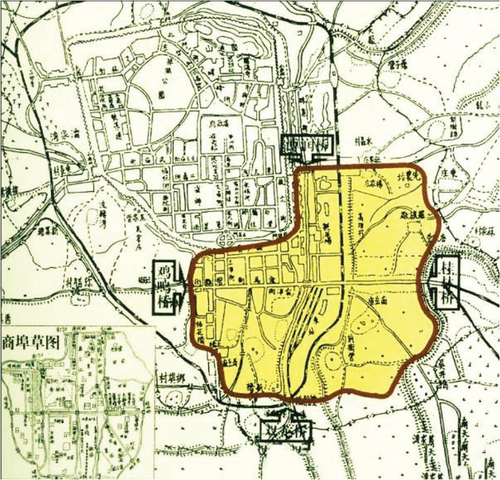
In 1922, Kunming officially became a “city” and in 1931, the “New Market Development Plan” proposed the renovation of the city’s main roads, the construction of parks and market areas, and the demolition of the city walls. Later, with the outbreak of the Sino-Japanese War, industries, schools, and financial businesses from other parts of China moved to Kunming, and the city developed further.
In 1939, Ding Jishi, then director of the Kunming Bureau of Engineering, proposed the “Grand Kunming City Plan,” and the first city plan of Kunming appeared.8 The “Great Kunming City Plan” mainly proposed the following.
The city limits and boundaries of Kunming City will be determined by focusing on the International Exhibition Center.
The construction of roads along the International Exhibition Center will ensure the connection with the urban transportation network and form the basic framework of land transportation. In addition, important wharves in the International Exhibition Center will be selected to form a water transportation network.
The scope of urban areas will be expanded. In addition, each cultural heritage site and natural tourist spot will be marked, and new construction projects along the International Exhibition Center will be regulated to a certain extent.
In 1941, Tang Ying, who took over as director of the Bureau of Engineering, prepared the “Outline of Kunming City Construction Plan” based on the “Grand Kunming City Plan,” complete with administrative, cultural, commercial, residential, industrial, green space, forest land, and pastoral areas, but due to the change of government with the establishment of the modern People’s Republic of China, implementation was postponed.
2.3. Construction of the Yunnan-Vietnam Railway
France obtained the legal basis for acquiring the right to lay the railroad under the Sino-French Treaty signed in June 1895 as compensation for the Tripartite Pact. The Yunnan-Vietnam Railway, which began in Hanoi, a former French colony in Vietnam, passed through the border between China and Vietnam, entered Yunnan, and extended from north of the river mouth to Kunming. The Yunnan-Vietnam Railway is 848 km long, 389 km in Vietnam. Construction began in 1901 and was completed in 1903. The total length of the railway is 466 km. Construction began in 1903 and the entire line was opened to traffic on 1 April 1901. The purpose of the construction was to allow France to expand its influence into southwestern China at the end of the 19th century. In 1903, the French government issued the “YunnanVietnam Railway regulation” (Yunnan-Vietnam Railway regulation), the main contents of which are as follows.
The construction of a railroad from Hekou to Yunnanbu (Kunming) by the French railroad company was approved, and after the completion of the main line, branch lines could be constructed, and the land occupied by the railroad would be provided by China free of charge.
Chinese authorities should assist the French government in purchasing materials, recruiting workers, acquiring land for the construction of the railroad, and other related matters.
Illegal criminal acts by foreigners should be handled by the French consulate.
Chinese local officials should protect the International Railway.
The import of machinery and cargo for the construction of the railroad should be exempted from taxation. ⑥ The Yunnan-Vietnam Railway should be returned to China after 80 years and the operating costs should be paid for that period.
The Yunnan-Vietnam Railway runs through the mountains and deep valleys of Yunnan with very large relative height differences, making the construction of the project very difficult and was called a construction miracle at the time. The highest point of the Yunnan-Vietnam Railway is Shuitang Station, 38 km away from Kunming, which is 2,026 m above sea level, and the lowest point is Hekou Station, 89 m above sea level, with a height difference of 1,937 m.
The Yunnan-Vietnam Railway became a commercial transportation line for transporting raw material resources and benefiting the colonial economy, as well as a transmission line for foreign culture. At the same time, the railroad promoted Yunnan’s shift from a natural economy to a commodity economy and promoted the development of modern industry and urban construction in Yunnan.
3. Characteristics of French inspired architecture in Kunming
3.1. Survey summary
The following is an introduction to the documents that will be used for the literature research in this study. We will mainly focus on the documents that refer to the construction of the railroad station and the architecture between 1903 and 1943 ().
Table 1. List of historical documents.
Of these, this article focus on (1) buildings that are described as “French Inspired buildings” or that basically meet the characteristics of French Inspired buildings (to be discussed in detail in Section 3.5), and 2) buildings constructed between 1903 and 1943. Buildings that meet both of the above criteria will be included in this study. A total of 36 buildings, including groups of buildings, will be selected, and their original use, current use, number of floors, structure, date of construction, address, whether they have been converted or not, and whether they have been reconstructed or not will be summarized as basic data for the study of French Inspired architecture in modern Kunming ().
Table 2. List of survey targets.
3.2. Traditional urban architecture in Kunming
3.2.1. Shiping hall ()
Figure 4. Floor plan and photographs of the stone folding hall.
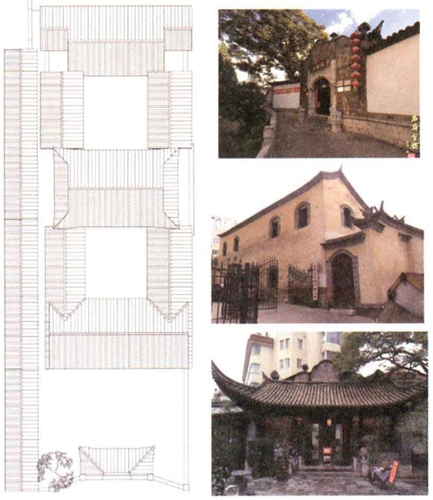
Shiping Hall, located at No. 24, Zhonghe Lane, Cuihu South Road, Kunming, was built in 1921 by Yuan Jiagu and Zhang Zhijiang, both from Shiping,9 to provide a temporary home and meeting place for students and merchants from Shiping in Kunming.
In terms of architectural form, the buildings of ShiPing Hall are wooden structures with an area of 1,660 square meters10 facing south with the structure of “one step, three courtyards, four sections, and five ceilings,” with an exact plan and closely connected courtyards. The courtyard is closely connected to the building, and the shape of the building is that of a Revolving corner,11 which enhances the whole hall.
There are blue stone tiles on the floor.12
The structure of the building is that of a traditional Chinese wooden structure.
The gable wall acts as a bearing wall and is fully constructed with few openings. The exterior walls are finished in earthen materials, except for the entrance wall, which is covered with blue stone and hung with lanterns to emphasize the white arches.
3.2.2. Ma family house ()
Figure 5. Photographs of the 1 Majiya great houses.

The Ma Family House was built in 1923 and is the residence of the Dali Ma family.
In terms of the architectural form, the Ma Family House adopts a Siheyuan building form with a 200-square-meter courtyard in the center, decorated with blue stone tiles, plants, and stone water jars. The building uses the “three-fang, one-light-wall”13 planar structure typical of the houses of the Bai people, but also incorporates the Kunming “single-branch mark”14 style.
The details of the building are as follows: a. Grid windows were used, b. doors were divided into six panels according to the size of the partition, c. wooden carved parapets were installed on the second floor, and the whole building was painted with elaborate colors, d. the roof was gabled and covered with blue tiles, and e. lanterns and marble sculptures were installed in the courtyard.
The structure of the building is made of traditional Chinese wood, and earth is added to form the skeleton of the building. The exterior walls retain the materiality of the wood and are covered with a deep red lacquer.
3.2.3. Kunhua medical clinic warehouse ()
Figure 6. Photo of the warehouse of Kunhua medical clinic 1.
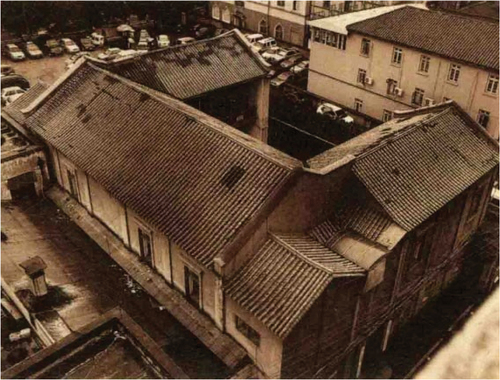
Figure 7. Photo of the warehouse of Kunhua medical clinic 2.
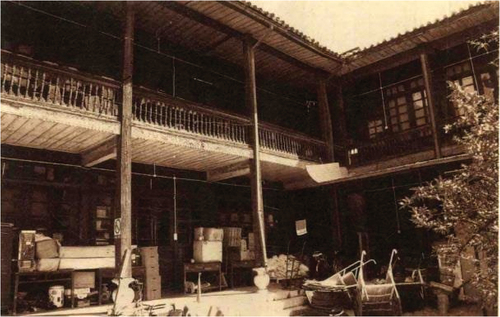
In 1938, the Yunnan Provincial Government converted the Jinbi Park, which was built in the late Qing Dynasty, into the Kunhua Medical Clinic and built this warehouse. The building area of the Kunhua Hospital Warehouse is about 800 square meters, and it was registered as a cultural asset of Kunming City in 2002.
In terms of architectural form, the warehouse of Kunhua Hospital adopts a two-story/threestory building with openings facing the street for cargo access.
a. The building uses the “three pavilions and one illuminated wall” floor plan, while retaining a large courtyard to maintain the function of a warehouse. b. The building has a large, open courtyard.
The structure of the building is a traditional Chinese wooden structure. The skeleton of the building is formed by adding soil, and the exterior walls are covered with lime.
3.3. French inspired urban architecture in Kunming
3.3.1. Hui Ze Yuan ()
Figure 8. Plans of the Hui Ze Yuan.
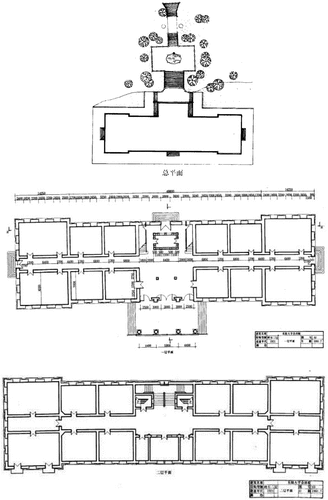
Figure 9. Elevation view of Hui Ze Yuan.

Figure 10. Detail structure of the Hui Ze Yuan.
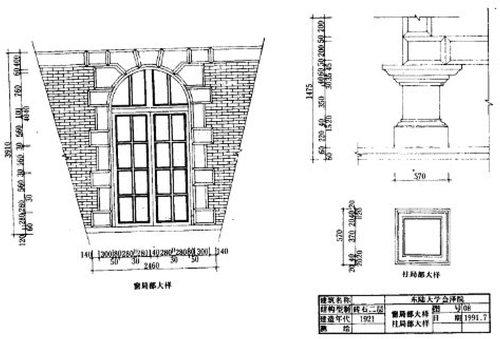
Hui Ze Yuan was built in 1923 as a building for the literature and law departments and the library of Yunnan University (then Dong Lu University), and is the largest building on campus.15 The designer is unknown, but according to the interview survey, the builder was a Chinese master builder. It is one of the largest and most perfectly preserved French Inspired buildings in Kunming modern architecture. It is also said that the architectural style of Hui Ze Yuan was based on the commercial architecture of the trade zone around the Yunnan-Vietnam Railway Station.
In terms of the architectural location, Hui Ze Yuan is located on a hill with a high terrain. a. The total of 95 stairs symbolizes the traditional Chinese “Ninety-Five Supremes,”16 which usually indicates the high status of the owner and is often used in old Chinese palaces. The platform on the way to the temple forms a small plaza with fountains.
Regarding the architectural form, Hui Ze Yuan faces south. b. The plan is symmetrical based on a central axis. The three openings in the center are the entrance corridors, running through the first and second floors, and c. supported by four pillars 10 meters high and 90 cm in diameter.
In terms of architectural details, the exterior and interior floors are covered with the same vivid mosaic tiles. d. The entrance door is made of iron with a dense curved pattern, creating a grand atmosphere.
Regarding the elevation of the building, e. It is sorted into five levels above and below; the bottom is a base 1 m high with vents to the basement level. f. The top is a parapet in the style of eaves and vase parapet. The windows on the first floor are vertical squares, the windows on the second floor are arched, and the exterior is fitted with gray-white stones, giving it a distinctive French Inspired.
Regarding the structure and materials of the building, g. The foundation and elevations are made of blue stone, the main part of the building is made of 200 × 60 mm tiles, and the interior is covered with white lime.
As mentioned above, Hui Ze Yuan is considered the most typical French architecture in Kunming, and almost no elements of Chinese style architecture were used.
3.3.2. Yunnan Army Military College ()
Figure 11. Plan of the Yunnan Army Military College.
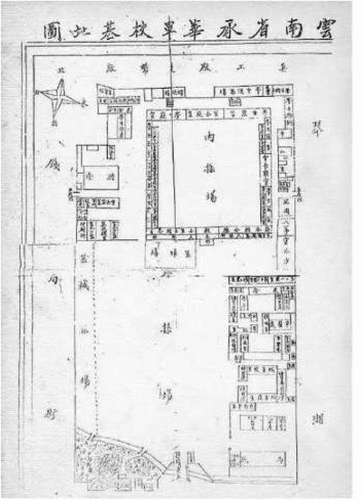
The Yunnan Army Military College is a famous early military academy that had an important impact on China’s modern history. At the end of the Qing Dynasty, it was called one of the largest military academies of its time. In the Republic of China, it was also known as one of the “Three Great Military Schools”, the construction of the school began in 1907 and was completed in 1909.
In terms of architectural form, the original area was about 70,000 square meters, and the current main building covers an area of 7,600 square meters. a. It consists of the main building, internal and external training areas, armory, auditorium, toilets, illuminated walls, small flower garden, stables and other parts.
Architectural details, b. The building’s corridor is called the largest architectural corridor in China, with four wings (east, south, west, and north) connected into one, 480 meters long; the grand scale of the corridor is unique among the lecture halls of its time.17 c. The roof is a Chinese-style herringbone slope covered with black tiles, and the doors and windows are decorated with Western-style arched ornaments. d. The exterior walls are painted a bright yellow, and the ginger-yellow main entrance incorporates elements of French Inspired architecture. e. The main entrance is a large, open-ceilinged room with a large window.
The structure of the building is a combination of earth, wood, and stone, using the advanced masonry of the time.
As mentioned above, the Yunnan Army Military College is one of Kunming’s embodiments of the modern French neoclassical architectural inspiration, but it also shows vestiges of traditional Chinese architectural elements, such as the planar composition and roof.
3.3.3. Lu Han Mansion ()
Figure 13. Photograph of the Lu Han mansion.
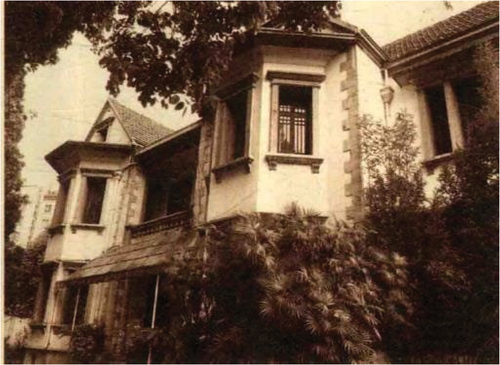
Figure 14. The Lu Han establishment.
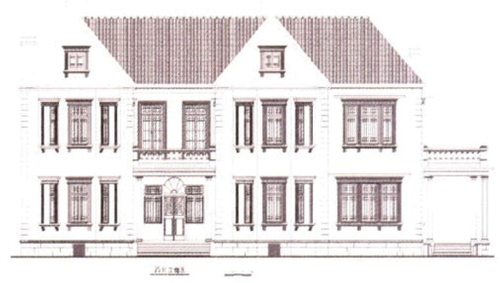
Lu Han graduated from the Military Academy of the Army, served in the Yunnan Province Transportation Corps, and was appointed the Chief of Yunnan Province in 1945; he was nicknamed the “Last King of Yunnan.” Lu Han Mansion was his private residence, a typical French Inspired villa with a garden.
As for the architectural form, it is octagonal in plan, and the design of the European villa can be seen. The courtyard is used as a garden, and the landscaping of the garden is based on European garden elements.
In terms of architectural details,18 a. Numerous stone carved ornaments were used, including stone pillars, portal ornaments, and window ornaments. b. The roof is steeply pitched, tiled, and equilateral triangular both in the front and on the sides, showing a characteristic Gothic style. c. The window installation is concise and flexible, with emphasis on geometric aesthetics. d. The windows are all made of imported teak wood, as are the interiors, and a fireplace is attached to the living room. In addition, a picture window connecting to the veranda is installed in the bedroom, pursuing a contemporary elevation and ensuring interior lighting.
Regarding the structure of the building, the Lu Han Mansion is a two-story building with a wooden framework and brick walls, some of which are RC structures. e. The architecture combines red tiles and white walls, and the gray border fuses them together, emphasizing harmony and aesthetics. f. The building has a high ceiling height.
While the Lu Han Mansion is a representative example of French Inspired residential architecture, its concise decorations also show the characteristics of modernist architecture.
3.3.4. Tang Jiyao’s tomb ()
The tomb of Tang was built in 1932; its height is 6 meters, its diameter is 16 meters, and its area is 1,500 square meters. Tang Jiyao’s Tomb is a relatively large tomb in China. Most traditional Chinese tombs are built in arches with huge thick rocks, whose gaps are glued and usually curved to be integrated with the surrounding park forest.
On the other hand, the columns of the Tang Jiyao’s Tomb use the Greek Ionic style. a. The column cap consists of three parts: the architrave, the frieze, and the cornice. The frieze above it is richly carved, and the cornice has a dental ornament. In front of the tomb is a 16.70-meter-wide columned stone archway with eight stone monuments inscribed with the glories of Tang’s life, using the b. Latin inscription technique.
4. Construction process of French inspired architecture in Kunming
4.1. Housing construction
As mentioned earlier, before the 20th century, housing in Kunming was generally in the traditional Chinese style. With the construction of the Yunnan-Vietnam Railway, a large number of French Inspired residential buildings emerged().
Table 3. List of residential buildings.
There are two main types of residential construction.
French and Vietnamese residential
French Inspired housing for Chinese people
According to the existing documents, with the opening of the Yunnan-Vietnam Railway, the French built many foreign residences, consulates, and offices for the merchants coming and going from the concession (trade zone) in Kunming. As these buildings were run by foreigners for foreigners, the Chinese had no direct control over them. However, in Kunming, these buildings are largely unpreserved and there are few correlative records.
Unlike other concession cities in China, such as Qingdao and Dalian, the Kunming government has recognized these concession buildings as “negative heritage” and might even consciously remove them.
In 1923, in order to beautify the city, the Kunming Municipal Government planned to remove oldstyle buildings along the main streets and introduce new-style Western buildings.19 The owners were mainly upper class people who had studied in France or were interested in French culture. Therefore, these residential buildings are mainly located around the lake, along the urban axis, and in the center of the city (). Conversely, the fact that French houses are not preserved might have led to a negative perception of their owners by the Kunming municipal government.
4.2. Church architecture ()
In 1730,20 the Missions étrangères de Paris (M.E.P.) began its missionary work in Yunnan Province via Sichuan Province. In 1843, the first church office was built in Longxi Village to manage the affairs of the church in Yunnan Province, and in about 1865, the church moved its office to Kunming; from then on, missionary work was carried out in Kunming and other parts of Yunnan. By 1949, 96 churches had been built in Yunnan to minister to a population of more than 40,000 Christians.
Table 4. List of Church architectures.
The following table lists the churches built by the French in Kunming between 1901 and 1943, showing the influence of the construction of the Yunnan-Vietnam Railway on the construction of churches.
4.2.1. Colégio de São Paulo (Holy Presbyterian Church) ()
In 1911, French nuns established a branch church in Kunming, which was administered by the Diocese of Vietnam. Along with the establishment of the church, the St. Baoluo Orphanage, St. Baoluo School (which became Sophia School in 1947), and the Poor People’s Clinic were built around it. In 1943, the orphanage and clinic were moved to No. 14 Pingcheng Street, where there were farmland, flower gardens, and cattle breeding industry. In 1948, the nuns returned to France as caretakers, and the church went into decline.
4.2.2. Ordine francescano
These French monks began their missionary work in the province of Longchuan. In Kunming, a chapter was established in 1937 at No. 133, Guo Road, and moved to No. 12, Xing Ren Street in 1940; in 1945, Our Lady’s Clinic established in Kunming and in 1948, a kindergarten. In 1951, all the foreign monks and nuns returned home.
4.2.3. Ordo fratrum Beatæ Virginis Mariæ de Monte Carmelo
In 1936, French monks arrived in Kunming from Vietnam and founded the “Kunming Heavenly Bishop’s Holy Clothing Society” at No. 83, Pingcheng Street, and established a cattle farm at No. 18, Pingcheng Street.
4.2.4. Kunming catholic major seminary
Established in 1934 at No. 41, Pingcheng Street, Kunming, it aimed to train high-level personnel for the church. In addition to theology, church history, and dogmatics, the school also offered basic courses in Chinese, Latin, physics, chemistry, geology, and physiology. The first students graduated in 1940, and the school was closed in 1949 when the director returned to Taiwan.
4.2.5. Seminário and Igreja de São José
This was first established in Yanjin in 1881, and moved to Bailongtan, Kunming, in 1905. The purpose of this small monastery was to train lay monks and select the best of them for recommendation to the abbey. It was closed in 1951.
4.3. Commercial and financial architecture () ()
4.3.1. Banque de l’Indo-China, Kunming, France
French Kunming Oriental Lexis Bank is also known as Indochina Bank. It was first established in Vietnam with the investment of the French government’s Colonial Department (20%) and various large French banks. In 1910, with the opening of the Yunnan-Vietnam Railway Company, the need for foreign exchange increased with the increase of commercial traffic. However, the amount of money was so large that the Bank of France Kunming Oriental Lexis established a branch in Kunming.
Table 5. List of commercial and financial architectures.
In 1941, the Japanese occupied Vietnam and the business of the French Chamber of Commerce in Yunnan was also suspended due to the interruption of the Yunnan-Vietnam Railway.
4.3.2. Kunming subsidiary of France Longdong Co
France Longdong Limited was a private company established in 1912 by French merchant Louis Ron Don, mainly engaged in the import and export trade in China and Vietnam. The company was first established in Shanghai and then moved to Hong Kong after the outbreak of World War II. The company set up a Yunnan tin ore forging factory in Hanoi and established a subsidiary in Kunming in 1934.
The main business of French Longdong Limited Company was to sell arms and military supplies for the French arms trade, as well as military and civilian vehicles as an agent of General Motors Company of the U.S.A. After1940, with France’s defeat in Vietnam, the traffic on the Yunnan-Vietnam Railway was interrupted and French military supplies were reduced.
The Kunming Subsidiary of French Longdong Company Limited withdrew from Kunming in 1950. This company, the largest commercial company of the French empire in Yunnan, controlled the important import and export trade of Yunnan in that period.
4.4. School architecture ()
The ruling class in Kunming at that time was shocked by foreign colonial culture and felt the importance of human resource development. There was also an awareness of the need to raise the level of education within the country after sending talented students to study in France, Japan, Myanmar, and Vietnam. At that time, a large number of new schools were built in Kunming built under the influence of Western thought.
Table 6. List of school architectures.
Among military schools, the Army Elementary School, the Army Quickening School, and the Yunnan Army Lecture Hall were established, while vocational schools – the Kunhua Engineering College, Agricultural College, and Teacher’s College – and law, commerce, and railroad schools were newly established. The universities included Wuhua Academy and Donglu University (now Yunnan University), and among junior high schools, Kunhua Junior High School and Kunhua Girls’ Junior High School were built().
Of these, the French Inspired schools are as follows:
4.4.1. Yunan University (Donglu University), Huize campus
In 1919, Tang Ji Yao, the then governor of Yunnan Province, sponsored the construction of Donglu University, which was officially established in 1922; the name was changed to “Provincial Donglu University” in 1930, “Provincial Yunnan University” in 1934, “National Donglu University” in 1938, and “Yunnan University” in 1949. The management principle of Donglu University is “to add ethnicity to the speakers, to add ethnicity to the villagers, and to create specialty in ethnic customs, ”as well as to promote East Asian culture, research Western European studies, integrate Sino-Western truths, and create professional human resources.
In the construction of Donglu University, a number of excellent buildings were built with the help of experts from Yunnan Province. Features of Chinese and Western architecture were scattered throughout the school, creating a unique landscape of multicultural fusion.
In terms of Chinese-style architecture, Zhigong Hall(), built in 1499, and the Yingqiu Yuan(), built in 1938 as a women’s dormitory at that time, can be mentioned. Zhigong Hall was converted into an auditorium for Yunnan University in the 1940s. In 1987, these two buildings were registered as cultural assets of Yunnan Province.
On the other hand, Zhang Bang-han, the designer of the Hui Ze Yuan, studied in France, adopted its architectural culture, and led the construction of the Hui Ze Yuan in 1922. The building, as mentioned above, is one of the most typical French Inspired buildings existing in Kunming. The style of the Hui Ze Yuan was used as the basis for the school emblem of Yunnan University, and all the new buildings constructed at Yunnan University around 2010 were built in the French Inspired, showing the profound influence of French architectural culture.
4.4.2. Kunming Chinese-French school
In 1889, French forces began to expand into Yunnan and created organizations such as customs, banks, medical clinics, Western banks, railroads, and postal services. In 1901, the French government established the Chinese-French School in Kunming in order to train ordinary Chinese employees in these organizations to be fluent in French. The school was divided into two sections, male and female, with the same location but different entrances and exits. The school established five classes and had more than 100 students. Regarding the content of the classes, French was the main language of instruction, and the best graduates would be sent to universities in Shanghai or to medical, commercial, and engineering schools in Hanoi at public expense. In addition, students who remained in Yunnan were mainly employed by organizations affiliated with the French government (including French consulates), and were often assigned to the secretarial, interpretation, or purchasing departments.
The Kunming Chinese-French School was under the direct supervision of the French Consulate and was funded by the French government. The school was first located in Jinxin Temple, Kunzhi Lane, West Huashan Road, Kunming, and was moved to No. 173, Amijangli in 1925 after a fire. With the defeat of France in World War II, the withdrawal of the French organization in Kunming began. In 1944, the school’s principal reached an agreement with the consul of the French consulate to change the school to a private junior high school. In 1949, the school opened seven new classes, including a second foreign language course, and enrolled more than 300 students. In 1950, the principal returned to France, the school was closed down, and the teachers, students, and educational equipment were distributed to the various other junior high schools in a unified manner.
The Kunming Chinese-French School set up a translation office and translated newspapers, magazines, and historical and geographical documents of Yunnan for the French consulate, including “International Exhibition,” “Yunnan Tongzhi,” “Nanzhao Yushi,” and local historical documents and travelogues of Yunnan. In addition, the students were given the task of translating Chinese novels as homework for the course and for publication in France to promote cultural exchange.
4.4.3. Yunnan Army Military College
The Yunnan Army Military College was established in 1909 and closed in 1935; during its 26 years of operation, the school trained nearly 10,000 students. Between 1935 and 1945, the school name was changed to the “Fifth Branch of the Central Army Military Academy”; in 1953, it was renamed the Third Infantry School of the Chinese People’s Liberation Army and moved to a new location in 1958. In 1988, the Yunnan Army Military College was registered as a Chinese national cultural relic, and the Yunnan Military Academy History Museum was established in 2009.
The purpose of the school was to train military personnel who would be loyal to the Qing government, but the actual management power was in the hands of the revolutionary party. On the day of the opening of the Yunnan-Vietnam Railway in 1910, Li Gen Yuan, the president of the school, gave a lecture to all the students, “The French railroad has reached Kunming … China has lost its power as a nation, and we soldiers should protect this country.” In addition, he took all the students to visit the Yunnan-Vietnam Railway Kunming Station as part of their patriotic education.
The present Yunnan Army Military College has been repaired many times and its area has been reduced by half. The current Kunming government has renovated it into a museum to commemorate China’s modern revolution, thus achieving both protection and development of the building. However, as mentioned above, while the Yunnan Military Academy was one of the characteristic urban buildings that combined French architectural elements, the current tourism content does not include much about French culture.
4.5. Hpspital architecture ()
With the influx of British and French government departments and church architecture 21 into Kunming, many Western clinics were built that were useful not only in introducing Western treatment methods to Kunming, but also in spreading knowledge of hygiene and preventing infectious diseases. After the establishment of the People’s Republic of China, these clinics were closed down or their power was transferred to the Chinese government. At that time, most of the foreign medical personnel, except for the Vietnamese employees of the Ganmei Clinic, left Kunming ().
Table 7. Hospital architecture list.
4.5.1. Daibutsu clinic (Railway clinic)
In 1901, the French built the Great Buddha Medical Clinic, which was directly managed by the French Consulate and headed by a Frenchman, Moulayar (Ong); his deputy was a Vietnamese man, Pei Bun Ki. At that time, there were about 10 medical employees, and a classification system was used for the sick, charging five yuan for each visit by the first-class sick and providing free medical examinations to poor citizens, as well as low-cost fever and diarrhea remedies.
In 1910, with the opening of the Yunnan-Vietnam Railway, the name of the clinic was changed to the Railway Clinic. In 1912, in order to expand the scale of the clinic, with funds from the Yunnan Office of the French Ministry of Foreign Affairs and the Yunnan-Vietnam Railway Company, the clinic acquired a plot of land at No. 35, Xunjin Street, Kunming City, and began construction of the Ganmei Clinic, which was later put on hold. In 1941, the Yunnan Provincial Government and the French Consulate negotiated to change the ownership of the railroad clinic and renamed it to Renmin Medical Clinic, its current name.
4.5.2. Ganmei clinic
As mentioned above, the Ganmei Clinic inherited the doctors and instruments of the Great French Clinic, and as it was under the control of the French diplomatic and colonial service, it was also called the “French Consular Clinic.” The five directors of the clinic were all French nationals commissioned by the French government, and the main staff members were under the direction of the Governor General of Vietnam and received their salary directly from the French Consulate ().
The Ganmei Clinic submitted financial reports to the French consulate once or twice a month, and the medicines used were directly transported from Vietnam to Kunming via the Yunnan-Vietnam Railway.
In 1950, the Yunnan University School of Medicine accepted the Ganmei Clinic and made it an affiliated clinic of Yunnan University. Many French-speaking graduates have been employed at the clinic, and exchange programs with France have continued.
The Ganmei Clinic is a typical French Inspired building. It has two floors above ground and one basement floor with a total area of 400 square meters, and a total floor area of 600 square meters. It has a two-story corridor with ornate decorations such as carved columns. The roof also has Gothic lancet elements, showing the typical Western architectural style.
4.6. Other Western architecture ()
The opening of the Yunnan-Vietnam Railway brought many Western cultural elements to Kunming, including French culture, and Western architecture influenced by other cultures was also built. The following is a brief description of some representative examples.
Table 8. List of other Western architecture.
In 1903, the British established a consulate in Kunming and also participated in the construction of the Yunnan-Vietnam Railway, which led to the construction of certain British-style buildings. However, the appearance of British-style buildings was relatively late compared to that of French Inspired buildings. Other Western-style buildings appeared mostly after the opening of the Yunnan-Vietnam Railway. In addition, after France was defeated in 1940, some French facilities such as the Yunnan Post Administration Bureau and Kunming Haiguan were confiscated.
These buildings were distributed within a relatively small zone in the city center, mainly located in the southern trade zone, where the economy of scale led to a concentration of activities and greater convenience().
5. French inspired architecture and the urban landscape of Kunming
5.1. A timeline of the emergence of French inspired architecture
The above timeline of the emergence of French Inspired urban architecture allows us to create the following chronology()().
Figure 25. Timeline of the emergence of French inspired architecture in urban space.
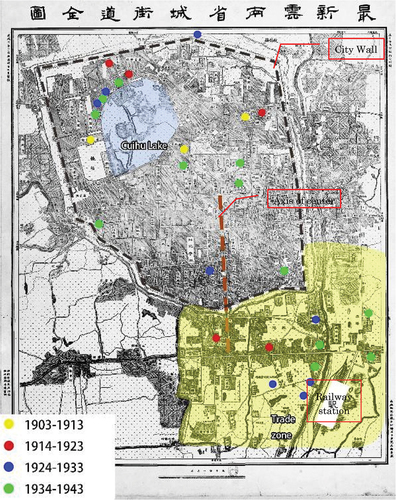
Table 9. Chronology of the emergence of French inspired architecture.
Regarding the number of French Inspired urban buildings, there is an overall increasing trend. By type, residential buildings appeared more slowly than the other types.
Therefore, the emergence of French Inspired architecture, which is the subject of this study, can be divided into three major periods.
The period between 1903 and 1913 saw the introduction of the railroad station, and public buildings such as churches, schools, and medical clinic buildings emerged first. As largescale transportation had not started yet, the main purpose of this project was to develop human resources and spread culture, focused on future development.
The period from 1914 to 1933 was the period of the development of the Yunnan-Vietnam Railway Station, when residential buildings started to gradually appear and fewer public buildings were constructed than in the previous period, though still showing development. In this period, the influence of the railroad on the general public gradually increased and brought prosperity to the trade zone.
The 1934–1943 period was a prosperous period for the railroad station, and a large number of French Inspired residential buildings appeared. With the increase in the number of users, the increase of public buildings could be reconstructed to meet their needs.
The following characteristics can be observed regarding the chronology of French Inspired urban architecture in the urban space.
On the whole, French Inspired buildings tended to be located around Cuihu Lake in the northwest and the Yunnan-Vietnam Railway Station in the southeast.
All of the French Inspired buildings built between 1903 and 1913 (yellow dots) were scattered within the city walls and tended to be located in the center of the city.
In the period 1914–1933 (red and blue dots), the location of French Inspired buildings tended to move north to south.
The period 1934–1943 (green dots) was a period of prosperity, when French Inspired architecture continued to appear around Cuihu Lake in the northwest and the Yunnan-Vietnam Railway in the southeast, but also reappeared in the center of the city.
As described above, the emergence of French Inspired architecture in Kunming’s urban space can be characterized over time as proceeding from the center to the north and south, and to the center again.
The reasons for this may be as follows.
All of the French Inspired buildings constructed during the introduction of the YunnanVietnam Railroad were public buildings, so they were located in the center of the city to serve the entire city of Kunming.
The public buildings constructed during the development period of the Yunnan-Vietnam Railroad can be considered to have been intended to serve functions around the railroad instead of the central urban area of the city. French Inspired buildings appeared in the early days, and their owners were mostly upper-class people who tended to move to the area around Cuihu Lake, where the living environment was good.
The French Inspired architecture built during the prosperous period of the railroad station inherited the characteristics of the earlier period, while the influence of French culture on the citizens was strengthened and appeared again in the center of the city.
5.2. Construction of French inspired buildings and their removal status ()
The construction entities of the French Inspired buildings under investigation in this study are as follows. Out of a total of 36 French Inspired buildings, 10 were built by the French and 26 by the Chinese, with the Chinese being the main builders in general. Of the total of 12 public buildings, 10 were built by the French and 2 by the Chinese, indicating that the French were the overwhelming majority.
There must have actually been more buildings built by the French, but as mentioned in Section 4.1, the state of preservation of French houses and the negative attitude of the government are possible reasons for the sparseness of their documentary record. On the other hand, the French built many public buildings in Kunming and influenced the development of Kunming in all aspects, such as religion, schools, medical clinics, commerce, and finance. The attitude of the French of investing in Kunming can be seen. The Chinese in Kunming also embraced the French Inspired of architecture, especially the upper classes, and while there was an attitude of imitating the style, there was also a preservation of elements of Chinese-style architecture.
shows the distribution of French Inspired buildings in Kunming by construction entity. The number of buildings built by the Chinese was relatively large, and they tended to be located in the trade zone around Cuihu Lake and around the Yunnan-Vietnam Railway Station. On the other hand, French buildings tended to be located along the city’s central axis and in the trade zone, because in addition to satisfying the demand for trade, the Chinese imitated the French Inspired of architecture and formed a residential area that became a temporary trend, while French architecture tended to affect the whole city of Kunming.
Regarding the removal status of French Inspired buildings, which is the subject of this study, out of a total of 36 buildings, 15 were removed and 21 were preserved. In comparison to the construction entities mentioned above, the buildings that were retained were mostly Chinese buildings and public buildings built by the French.
As for the removal of French Inspired buildings in the urban space, the French Inspired buildings that were removed were mainly located in the trade zone around the Yunnan-Vietnam Railway Station and in the city center within the city wall.
5.3. French inspired architecture and urban planning in Kunming
5.3.1. Changes in urban planning
In 1982, Kunming was registered as a “Famous City of Chinese National History and Culture.” After that, the master plan of Kunming City formulated in 1996 designated the historical protection area, including the old city surrounded by the city wall and the trade zone around the Yunnan-Vietnam Railway Station ().
Figure 28. Historic preservation districts in 1996.
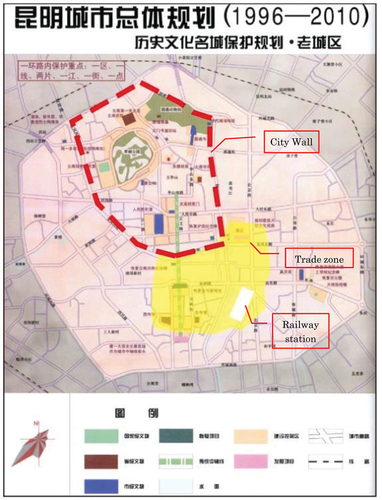
However, during that period, large-scale urban development took place, and uncontrolled urban expansion occurred with the construction of numerous high-rise buildings and the building of more roads. In addition to the traditional Chinese architecture, there was also extensive removal of the aforementioned modern French urban architecture.
Later, in 2014, the new protection plan pointed out that “the scope is excessive and the ancient city landscape is disappearing” and limited the scope of the historic protection area to the ancient city wall and along the city’s central axis, according to the provision that “the transition area of the Kunming ancient city pond is relatively concentrated, and Zhongqing City and Yunnanfu City are the concentrated areas of historical and cultural value in Kunming city” (). The railroad station in the city center was removed for the construction of the subway, and the surrounding areas were also removed from the protection area.
Figure 29. Historic preservation districts in 2014.
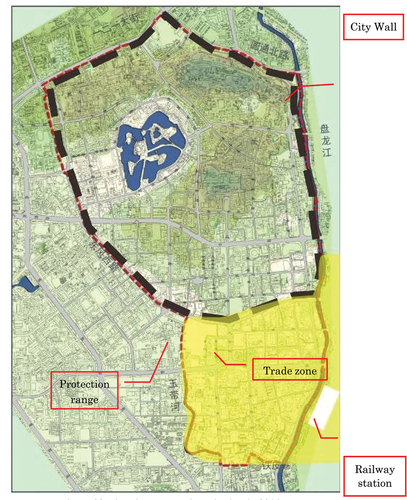
On the other hand, there was some protection for the railroad station outside the city area.22 The buildings along the railroad and the railroad itself have been repaired and protected, and any obstruction is prohibited. The railway cars and other relics are preserved and displayed in the Yunnan Railway Museum and Jizhuang Station Exhibition Hall. In the medium term, the historical and cultural significance of the Yunnan-Vietnam Railway and the cultural value of its heritage will be deeply explored, and the relevant railroad buildings and facilities will be properly displayed and utilized. In the long term, it will promote regional and international coordination of cultural line protection by connecting the cultural lines of the Yunnan-Vietnam Railway to other parts of Yunnan and Vietnam.
5.3.2. Yunnan University historic preservation area ()
Figure 30. History preservation area of Yunnan University.
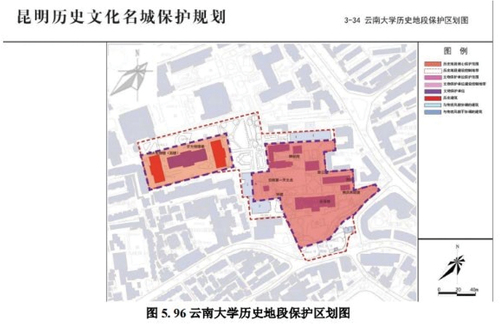
As mentioned above, the preservation of the railroad station and the surrounding trade zone has been stagnant, but some preservation of French Inspired urban architecture can be seen in the city. A number of French Inspired buildings have been registered as national, provincial, and municipal cultural assets, and protected areas have been formed around them.
As mentioned in Section 3.4.1, the Hui Ze Yuan of Yunnan University is recognized as the most characteristic French Inspired architecture in modern Kunming. In addition to the Hui Ze Yuan and Xiong Qing Lai’s residence, the Physics Building, the Biology Building, and the Bell Tower, which were built after the 1950s, also inherited the inspiration of French architecture, forming a distinctive group of French Inspired buildings.
The Yunnan University Historic Preservation Zone covers an area of 6.3 hectares that includes the Core Protection Zone and the Construction Management Zone(). The core protection zone is divided into two areas: The western part is centered on the Yunnan University Physics Hall and the Biology Building, covering an area of 1.1 hectares, while the eastern part is centered on the Hui Ze Yuan and covers an area of 2.9 hectares.
Figure 31. Protected area of French Inspired buildings.
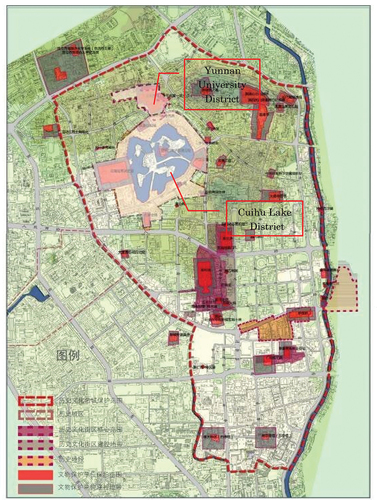
Strict protection measures and regular repair of buildings in the district will be implemented.
5.3.3. Cuihu Lake historic preserve ()
Figure 32. Cuihu lake historic preservation area parcel.
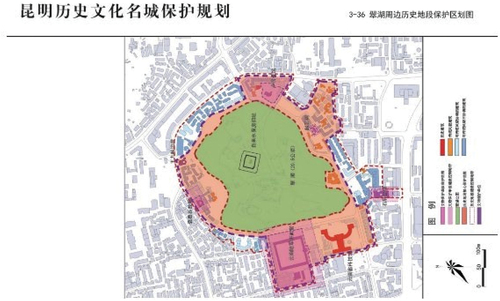
The area around the Cuihu Lake is the traditional core area of Kunming and is an important window onto the historical and cultural significance, folklore, and social life of Kunming. The Cuihu Lake Historical Preservation Zone covers 25.8 hectares and includes a core conservation area and a construction management area. Among the conservation areas, the French Inspired buildings of Yunnan Army Academy, Lu Han Mansion, Wang Jiu-ling Mansion, and Yuan Jia Gu Mansion are registered as cultural properties and located in the core conservation area. In the construction management zone, there are many other French Inspired residences, which are defined as “architecture in harmony with the surrounding environment and landscape” in the protection plan.
The conservation measures for the Cuihu Lake Historic Preservation Area are as follows:
Protect the “historic environment” in which cultural heritage and historic buildings are located.
Strictly protect and restore the spatial linkage of views such as “Cuihu-Yuantong Mountain” and “Cuihu-Daguan Tower.”
Protect the ecological environment of Cuihu Lake, do not destroy water quality and plant diversity, and do not reduce the existing green coverage.
Strengthen control over the style, volume, and color of new buildings.
Preserve the cultural atmosphere around the Cuihu Lake and actively utilize its unique geographical and cultural resources to gradually form an influential cultural and industrial cluster.
6. Conclusion
The opening of the Yunnan-Vietnam Railway has had two major effects on the city. The first is the expansion of the urban area. Kunming began to have trade relations with Belgium, France, Britain, Germany, the United States, Norway, Sweden, and other western countries. With the opening of the new railroad line, additional production materials such as machinery, vehicles, cement, and building materials, were sold, and the increase in the variety of goods sold stimulated the economy of the local market. With the prosperity of the economy, the trade zone area gradually became a place where people could come and go for economic activities, and people’s activities were concentrated in an area spreading from the city to the commercial port area outside the city, which led to the expansion of the urban area.
The second was the change in urban form from closed to open. However, in 1905, due to the increase of trade demand brought about by the construction of the Yunnan-Vietnam Railway, the Kunming government adopted the suggestion of local merchants and built a trade zone of about 12 square kilometers in the southeast of Kunming City. The opening of the new Yunnan-Vietnam Railway, brought about a major change in urban space, breaking through the urban form and city walls that had been emphasized by the Ming and Qing dynasties. Due to the influence of its commercial and economic functions, the trade zone gradually became the main place for public activities in Kunming, which gradually changed from a closed city to an open city.
Before the arrival of French architecture in Kunming, the main structure of the building was a wooden frame structure, and the emergence of a mixed structure of brick (stone) and wood opened new possibilities for the development of Kunming architecture. In addition, Western aesthetics became popular, and Western architecture emerged with the French Inspired as its representative, and the styles of decorative columns and semi-circular windows were applied to architecture. In addition, modern interior decoration such as mosaic tiles appeared in the interiors. Apart from these elements, the French Inspired architecture in Kunming has retained many of the architectural features of the mainland, constituting a fusion and symbiosis of different cultures.
As for the distribution of French Inspired architecture, residential buildings tended to be located around Cuihu Lake, suggesting the presence of upper-class Chinese. Churches tended to be located in the center of the city and around the railroad station, suggesting missionary intentions. The rapid development of the trade zone had a great impact on the commercial and Financial Architectures. The purpose of the construction can be divided into three stages: “to foster French-speaking people,” “to integrate Chinese and Western culture,” and “to rebel against French colonization.” Turning to clinics, the first was located near the French consulate, convenient for management and the general public, while the Ganmei Clinic was located near the Yunnan-Vietnam Railway Station because the users of the clinic were railroad employees and Vietnamese/French merchants; the Ganmei Clinic also developed into a “noble clinic.”
Chronologically, there is a relatively clear trend in the emergence of French Inspired urban architecture related to the amount of freight transported, showing the influence of economic development on the construction of architecture. Regarding the chronological sequence of the emergence of French Inspired architecture in urban space, it can be characterized as central, then northsouth, then central again over time. The first public buildings tended to function in the center of the city, and later, with the development of railroads, in the trade zones. Later, French architectural culture influenced the upper class of Kunming, and many French Inspired houses appeared around Cuihu Lake. Finally, the prosperous period of the Yunnan-Vietnam Railway brought more French culture to Kunming, and French Inspired buildings appeared again in the center of the city, inheriting the characteristics of the earlier period. However, although French Inspired architecture and aesthetics have been approved, what has been preserved until now is mostly architecture built by the Chinese. The rest of the buildings were demolished around 1950, and in many cases no records were kept.
The French Inspired buildings in Kunming exhibit certain historical and cultural values. However, with wars and economic decline, some of these buildings have been destroyed and others will disappear forever, making it imperative to conduct a conservation study of these French buildings.In recent years, the protection and conversion of French Inspired architecture has occurred in line with the government’s growing awareness of cultural heritage protection. Until now, this architecture has often been perceived as “negative heritage,” associated with the entry of French forces into China. Therefore, it is necessary to reaffirm the historical and cultural value of the French Inspired urban architecture in Kunming on the occasion of the registration of the Yunnan-Vietnam Railway Station as a World Cultural Heritage Site.
Disclosure statement
No potential conflict of interest was reported by the author(s).
Additional information
Funding
References
- Articles
- Benshu, X., and L. Jiang. 1997. History of Modern Kunming City. Yunnnan: Yunnan University Press.
- Books
- Chen, S. 2018. “The Opening of Ports and Commerce and the Urban Transformation of Modern Kunming (1840-1911).” Journal of Yuxi Teachers College 34 (5): 24–30.
- Chenggong, H. 1908. Kunming County Journal. Cheng Wen.
- Chenggong, H. 1924. Kunming City Journal. Cheng Wen.
- Dayu, Y. 2020. “The Diverse Integration of Modern Architectural Remains in Kunming.” Famous Cities of China 66–73.
- Dong, J. 2008. “The Influence of Local Architecture and Foreign Culture: The Case of Kunming’s Local Modern Architecture.” Master’s thesis, Kunming University of Technology.
- Editorial Board of Kunming City Government Monthly. 1947. “The City Government of Kunming.” Kunming City Government Monthly. 1947-01.
- Fengyue, Z. 2009. Planning Kunming. Yunnan People’s Publishing House.
- HP
- Ibos, P. 1910. Le Chemin de fer du Yunnan. IMPRIMERIE G. GOURY.
- Irwin, D. 2001. Neoclassicism, Iwanami Shoten.
- Kakizaki, I. 2013. “The Economic Role of the Chianetsu Railway.” Yokohama City University Thesis Humanities Series 65: 183–216.
- Knopf, A. A. 1986. McAlester, Virginia & Lee, A Field Guide to American Houses. New York.
- Kunming–Haiphong railway was nominated for the World Cultural Heritage List. Accessed 1 December 2020 https://baijiahao.baidu.com/s?id=1634196678259783970&wfr=spider&for=pc
- Kunming City Library. Accessed 1 December 2020 kmlib.yn.cn
- Kunming City Planning Bureau. 1996. “Kunming City Master Plan 1996-2010.”
- Kunming City Planning Bureau. 2010. Kunming Listed and Protected Buildings. Yunnan University Press.
- Kunming City Planning Bureau. 2014. “Kunming Historic and Cultural City Protection Plan.”
- Kunming City Wen Shi Zi Liao Research Committee. 1987. Kunming Wen Shi Zi Liao Xuan Ji No. 13. Kunming City Wen Shi Zi Liao Research Committee.
- Kunming Wuhua District Magazine Editorial Committee. 1995. Wuhua District Magazine. Sichuan Dictionary Press.
- Lin, C. 2013. “Kunming–Haiphong Railway and the Change of Urban Form in Kunming, Republic of China.” Journal of Guangxi Normal University: Philosophy and Social Science Edition 2013 (3).
- Lin, C. 2013. “Urban Commercial Form in Kunming at the End of Qing and Beginning of Ming Dynasty.” Journal of Sichuan Nationalities University 22: 36–43.
- Luo, J. 2012. “The Construction of the Industrial Heritage Corridor of the Kunming–Haiphong Railway.” Master’s thesis, Yunnan University.
- Magazine
- Materials
- Min, W. 2017. “A Study of French Architecture in the Ports Opened by Treaty in Modern Yunnan.” Master’s thesis, Yunnan Agricultural University.
- The National Federation for UNESCO in Japan. Accessed 1 December 2020 https://www.unesco.or.jp/activities/isan/decides/
- Nobutaka, S. 1992. “Yunnan Railway and French Imperialism: Relying on French Diplomatic Documents.” Land System History, no. 136: 37–50.
- Qing Dynasty Government, French Government. 1895. ““Treaty of Qing France”《中法续议界务商务专条》.”
- Qing Dynasty Government, French Government. 1903. “Kunming–Haiphong Railway Constitution.”
- Shujie, W. 1987. Kunming Wen Shi Zi Liao Xuan Ji No. 10: Historical Materials on French and British Colonization. Kunming City Wen Shi Zi Liao Research Committee.
- Sijiu, Y. 1991. An Overview of Catholicism in Yunnan. Yunnan University Press.
- Tongsun, D. 1841. Kunming County Journal. Feng Huang.
- Wang, T. 1993. Modern Chinese Architecture: Kunming. China Architecture & Building Press.
- Xue, L. 2002. Chun Cheng Kunming: History, Modernity and Future. Yunnan Art.
- Yang, J. 2003. “The Influence of Western Architecture on Modern Architecture in Kunming (1899-1999).” Master’s thesis, Kunming University of Technology.
- Yang, P. 2016. “Outline of the Urban Construction Plan of Kunming during Republic of China Period.” Yunnan Provincial Archives.
- Yujie, F. 2008. “A Study of Regional Landscape System of Stations along Yunnan Section of Kunming–Haiphong Railway.” Master’s thesis, Kunming University of Science and Technology.
- Yunnan Local Magazine Editorial Committee. 1997. Yunnan Provincial Magazine No. 41, Construction Materials Industry Magazine. Yunnan People’s Publishing House.
- Yunnan Local Magazine Editorial Committee. 2002. Yunnan Provincial Magazine No. 69: Health Magazine. Yunnan People’s Publishing House.
- Yunnan Military Academy Museum of History. Accessed 1 December 2020 yunnanmilitaryacademymuseum.com
- Yunnan Provincial Archives. 2005. Yunnan Society in the Late Qing and Early Ming Dynasties. Yunnan People’s Publishing House.
- Yunnan University Archives. Accessed 1 December 2020 ynu.edu.cn
- Zhihua, C. 2004. History of Foreign Architecture. China Architecture & Building Press.

